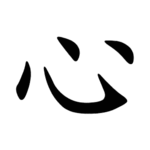| 心 | ||
|---|---|---|
| ||
| 心 (U+5FC3) "heart" | ||
| Pronunciations | ||
| Pinyin: | xīn | |
| Bopomofo: | ㄒㄧㄣ | |
| Gwoyeu Romatzyh: | shin | |
| Wade–Giles: | hsin1 | |
| Cantonese Yale: | sām | |
| Jyutping: | sam1 | |
| Pe̍h-ōe-jī: | sim | |
| Japanese Kana: | シン shin (on'yomi) こころ kokoro (kun'yomi) | |
| Sino-Korean: | 심 shim | |
| Names | ||
| Chinese name(s): | (忄) 豎心旁/竖心旁 shùxīnpáng (Bottom/⺗) 心字底 xīnzìdǐ (⺗) 豎心底/竖心底 shùxīndǐ | |
| Japanese name(s): | 心 kokoro (忄) 立心偏/りっしんべん risshinben (Bottom/㣺) 下心/したごころ shitagokoro | |
| Hangul: | 마음 maeum | |
| Stroke order animation | ||
 | ||
Radical 61 or radical heart (心部) meaning "heart" is one of 34 of the 214 Kangxi radicals that are composed of 4 strokes.
When appearing at the left side of a Chinese character, the radical transforms into 忄, which consists of three strokes. When appearing at the bottom, it sometimes transforms into ⺗.
In the Kangxi Dictionary, there are 1,115 characters (out of 40,000) to be found under this radical.
心 is also the 98th indexing component in the Table of Indexing Chinese Character Components predominantly adopted by Simplified Chinese dictionaries published in mainland China. Two associated indexing components, 忄 and ⺗, are affiliated to the principal indexing component 心.
YouTube Encyclopedic
-
1/2Views:28 783859
-
Chinese character 心 (xīn, heart) with stroke order and pronunciation
-
Chinese Character 心 Heart 💓
Transcription
Evolution
-
Oracle bone script character
-
Bronze script character
-
Large seal script character
-
Small seal script character
Derived characters
| Strokes | Characters |
|---|---|
| +0 | 心 忄 |
| +1 | 必 忆SC (=憶) |
| +2 | 忇 忈 (=仁 -> 人) 忉 忊 |
| +3 | 忋 忌 忍 忎 忏 忐 忑 忒 忓 忔 忕 忖 志 忘 忙 忚 忛 応JP (=應) |
| +4 | 忝 忞 忟 忠 忡 忢 忣 忤 忥 忦 忧SC (=憂) 忨 忩 忪 快 忬 忭 忮 忯 忰 (=悴) 忱 忲 忳 忴 念 忶 忷 忸 忹 忺 忻 忼 忽 忾 忿 怀SC (=懷) 态SC (=態) 怂SC (=慫) 怃SC (=憮) 怄SC (=慪) 怅SC (=悵) 怆SC (=愴) |
| +5 | 怇 怈 怉 怊 怋 怌 怍 怎 怏 怐 怑 怒 怓 怔 怕 怖 怗 怘 怙 怚 怛 怜 思 怞 怟 怠 怡 怢 怣 怤 急 怦 性 怨 怩 怪 怫 怬 怭 怮 怯 怰 怱 怲 怳 (=恍) 怴 怵 怶 怷 怸 怹 怺 总SC (=總 -> 糸) 怼SC (=懟) 怽 怾 怿SC (=懌) |
| +6 | 恀 恁 恂 恃 恄 恅 恆 恇 恈 恉 恊 恋SC/恋JP (=戀) 恌 恍 恎 恏 恐 恑 恒SC/JP/variant (=恆) 恓 恔 恕 恖 恗 恘 恙 恚 恛 恜 恝 恞 恟 恠 恡 (=吝 -> 口) 恢 恣 恤 恥 恦 恧 恨 恩 恪 恫 恬 恭 恮 息 恰 恱 (=悅) 恲 恳SC (=懇) 恴 (=德 -> 彳) 恵JP (=惠) 恶SC (=惡) 恷 (=恘) 恸SC (=慟) 恹SC (=懨) 恺SC (=愷) 恻SC (=惻) 恼SC (=惱) 恽SC (=惲) 悔JP |
| +7 | 恾 恿 悀 悁 悂 悃 悄 悅 悆 悇 悈 悉 悊 悋 悌 悍 悎 悏 悐 悑 悒 悓 悔SC/TC/KO 悕 悖 悗 悘 悙 悚 悛 悜 悝 悞 悟 悠 悡 悢 患 悤 悥 悦SC/HK/JP (=悅) 悧 您 悩JP (=惱) 悪JP (=惡) 悫SC (=愨) 悬SC (=懸) 悭SC (=慳) 悮SC (=悞) 悯SC (=憫) |
| +8 | 悰 悱 悲 悳 (=德 -> 彳) 悴 悵 悶 悷 悸 悹 悺 悻 悼 悽 悾 悿 惀 惁 惂 惃 惄 情 惆 惇 惈 惉 惊SC (=驚 -> 馬) 惋 惌 惍 惎 惏 惐 惑 惒 惓 惔 惕 惖 (=惕) 惗 惘 惙 惚 惛 惜 惝 惞 惟 惠 惡 惢 惣 惤 惥 惦 惧SC/JP/variant (=懼) 惨SC (=慘) 惩SC (=懲) 惪 (=德 -> 彳) 惫SC (=憊) 惬SC (=愜) 惭SC (=慚) 惮SC (=憚) 惯SC (=慣) 惹SC variant 愥SC variant |
| +9 | 惰 惱 惲 想 惴 惵 惶 惷 惸 惹TC variant 惺 惻 惼 惽 (=惛) 惾 惿 愀 愁 愂 愃 愄 愅 愆 愇 愈 愉 愊 愋 愌 愍 愎 意 愐 愑 愒 愓 愔 愕 愖 愗 愘 愙 愚 愛 愜 愝 愞 感 愠SC (=慍) 愡 愢 愣 愤SC (=憤) 愥TC variant 愦SC (=憒) 慨 愧SC variant 慅SC variant 愲SC variant 愺SC variant 慌SC/JP variant |
| +10 | 愧TC variant 愨 愩 愪 愫 愬 愭 愮 愯 愰 愱 愲TC variant 愳 愴 愵 愶 愷 愸 愹 愺TC variant 愻 愼Kangxi (=慎) 愽 愾 愿 (also SC form of 願 -> 頁) 慀 慁 慂 慃 慄 慅TC variant 慆 慇 慈 慉 慊 態 慌TC variant 慍 慎SC/TC/慎JP 慏 慐 慕SC/JP 慔SC variant 慑SC (=懾) 慥SC variant 慩SC variant |
| +11 | 慕TC 慒 慓 慔TC variant 慕 慖 慗 慘 慙 慚 慛 慜 慝 慞 慟 慠 慡 慢 慣 慤 (=愨) 慥TC variant 慦 慧 慩TC variant 慪 慫 慬 慭SC (=憖) 慮 慯 慰 慱 慲 慳 慴 慵 慶 慷 慸 慹 慺 慻 慼 慽 慾 慿 (=憑) 憀 憁 憃 憄 憅 (=慟) 憆 憇 憈SC variant 憎JP 憨SC variant |
| +12 | 憎SC/TC 憂 憈TC variant 憉 憊 憋 憌 憍 憏 憐 憑 憒 憓 憔 憕 憖 憗 憘 憙 憚 憛 憜 憝 憞 憟 憠 憡 憢 憣 憥 憦 憧 憨TC variant 憩 憪 憫 憬 憭 憮 憯 憰 憱 憲 憳 憤SC/JP variant 憼SC variant 憽SC variant 懂SC variant 懊SC variant |
| +13 | 憤TC variant 憴 憵 憶 憷 憸 憹 憺 憻 憼TC variant 憽TC variant 憾 憿 懀 懁 懂TC variant 懃 懄 懅 懆 懇 懈 應 懊TC variant 懋 懌 懍 懎 懏 懐JP (=懷) 懑SC (=懣) 懒SC (=懶) 懓 懔SC/variant (=懍) 懕 懖 懜SC variant 懞SC variant |
| +14 | 懗 懘 懙 懚 懛 懜TC variant 懝 懞TC variant 懟 懠 懡 懢 懣 懤 懥 懦 懧 懨 懩 懪 懫 懬GB TC variant 懭GB TC variant 懮 懯 懰 懱 懲JP |
| +15 | 懬Traditional variant 懭Traditional variant 懲SC/TC 懳 懴 (=懺) |
| +16 | 懵 懶 懷 懸 |
| +17 | 懹 懺 懻 懽GB TC variant |
| +18 | 懼 懽Traditional variant (=歡 -> 欠) 懾 懿 |
| +19 | 戀 戁 戂 |
| +20 | 戃 戄 |
| +21 | 戅 (=戇) 戆SC (=戇) |
| +24 | 戇 |
Sinogram
As a single radical the Chinese character means heart. It is one of the Kyōiku kanji or Kanji taught in elementary school in Japan.[1] It is a second grade kanji.[1]
References
- ^ a b "The Kyoiku Kanji (教育漢字) - Kanshudo". www.kanshudo.com. Archived from the original on March 24, 2022. Retrieved 2023-05-06.
Literature
- Fazzioli, Edoardo (1987). Chinese calligraphy : from pictograph to ideogram : the history of 214 essential Chinese/Japanese characters. calligraphy by Rebecca Hon Ko. New York: Abbeville Press. ISBN 0-89659-774-1.
- Leyi Li: “Tracing the Roots of Chinese Characters: 500 Cases”. Beijing 1993, ISBN 978-7-5619-0204-2




